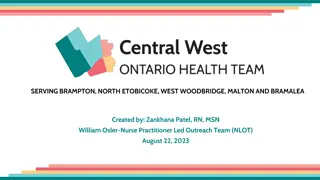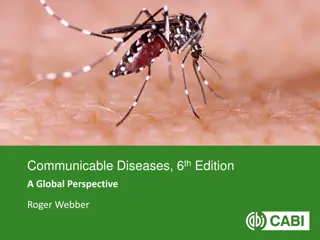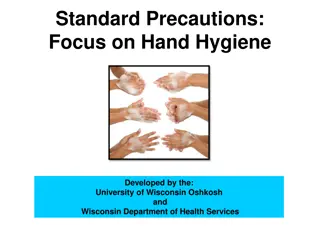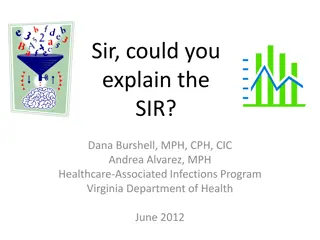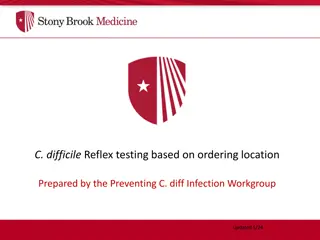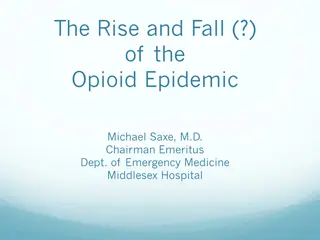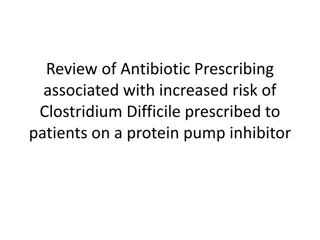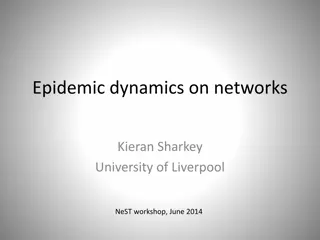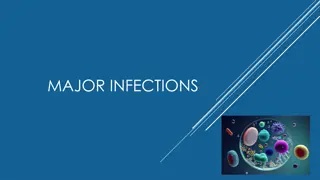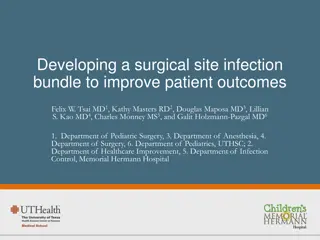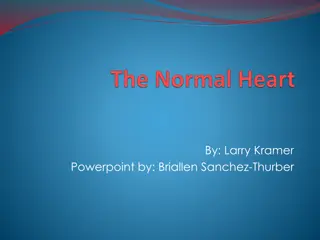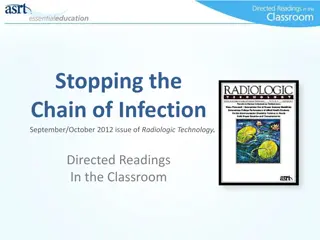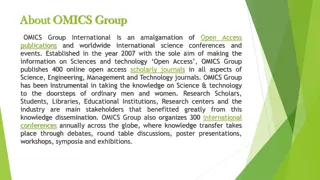Understanding the Epidemic of C. Difficile Infection: Insights and Implications
C. Difficile infection is a growing concern, with a significant impact on public health in the United States. High rates of infection and mortality, particularly among the elderly, highlight the urgent need for effective prevention and management strategies. The burden of C. Difficile infection extends across healthcare settings, with a notable recurrence rate adding to the complexity of addressing this issue. Surveillance data from New Mexico reveals the widespread impact of this infection on communities.
Download Presentation

Please find below an Image/Link to download the presentation.
The content on the website is provided AS IS for your information and personal use only. It may not be sold, licensed, or shared on other websites without obtaining consent from the author. Download presentation by click this link. If you encounter any issues during the download, it is possible that the publisher has removed the file from their server.
E N D
Presentation Transcript
C.Difficile an epidemic that is waiting for answers Michael Gavin MD Division of Gastroenterology University of New Mexico
Burden of Clostridium difficile Infection in the United States n engl j med 372;9 nejm.org february 26, 2015 C. difficile - almost half a million infections/yr Approximately 29,000 deaths in 2011 (within 30 days of infection) Persons 65 years of age or older, whites & females had higher incidences than their comparators.
C. Difficile Infection in the Elderly Keller JM Clinics in Geriatric Medicine 2014, 30:79-83. 92% deaths (C. Dif) occurred in age 65 & older Age itself is a risk factor -after age 65, risk increases 2% a year 50% of residents of long-term facilities are *asymptomatic carriers *(20% of hospitalized pts.)
C. Difficile Infection in the Elderly Keller JM Clinics in Geriatric Medicine 2014, 30:79-83. Increase rates- Severe Disease Medical complications Mortality
Burden of Clostridium difficile Infection in the United States n engl j med 372;9 nejm.org february 26, 2015 24% of cases occurred inhospital settings, (107,600 hospital-onset infections nationally) Of community-associated CDI, 82% estimated to be associated with outpatient health care exposure. The rate of asymptomatic colonization in nonhospitalized adults is to be 2%, with a higher rate, up to 26%, in those with health care exposures.
Burden of Clostridium difficile Infection in the United States n engl j med 372;9 nejm.org february 26, 2015 At least one recurrence of C. difficile infection occurred in approximately 21% of cases of health care associated infection 14% of cases of community-associated infection Est. burden of 83,000 first recurrent infections * repeated stool testing between 14 & 56 days after the initial C. difficile episode
Burden of Clostridium difficile Infection in the United States n engl j med 372;9 nejm.org february 26, 2015 Counties under Surveillance: (10 Nationally) New Mexico Bernalillo: 661,779 (population): Community-Associated CDI Cases: 354 Incidence per 100,000 Persons: 53.4 (All sites: 48.2) Health Care Associated CDI Cases: 727 Incidence per 100,000 Persons: 109.9 (All sites: 92.8)
Burden of Clostridium difficile Infection in the United States n engl j med 372;9 nejm.org february 26, 2015 NAP1 (PCR ribotypes 027): Binary toxin NAP4 (PCR ribotypes 020): NAP11(PCR ribotype 106): * The NAP1 strain was more common among health care associated cases than among community-associated cases (30.7% vs. 18.8%, P<0.001)
Pathogenesis Fecal-oral route (20% of hospitalized pts. colonized/hands of healthcare workers) Ingested: vegetative form or spores (resistant to gastric acid) Spores germinate in small intestine Colonization (colon)- microbiome disrupted by antibiotic therapy
Virulence factors Toxin A (TcdA) & Toxin (TcdB): exotoxins- bind human intestinal epithelial cells Tcd A- enterotoxin (+)IL-6, IL-8 (epithelial cells), plus IL-1, TNF-A (monocytes) Tcd B- cytotoxin cell retraction and apoptosis (grossly visible as cell rounding in tissue culture assays and as shallow ulceration on the intestine mucosal surface) Majority disease attributable to both toxins 7-10% B toxin only Binary toxin: different toxin and hypervirulent strains
Pseudomembranous Colitis Histopathology Type 1 PMC: mildest form (inflammatory changes confined to the superficial epithelium) Typical pseudomembranes are present Type 2 PMC: severe disruption of glands, marked mucin secretion, more intense inflammation of basal lamina Type 3 PMC: severe, intense necrosis of the full thickness of the mucosa with a confluent pseudomembrane
B1/NAP1/027* Name B1: by its pulsed-field gel electrophoresis (PFGE) patttern NAP1: North American PFGE type 1 pattern 027: PCR ribotype designation (Europe) Binary toxin*- similar to iota toxin of C.perfringens Produces higher levels of TcdA & TcdB -due to truncated tcdC gene (negative regulator) Resistant to fluoroquinolones * first reported in Canada (2004) * an enzymatic & a binding component Ananthakrishnan NR: Gastroenterology & Hepatology 8:17-25
Antibiotics Prior Exposure Antibiotics: 85% pts with CDI within 28 days Antibiotic Utilization: Increased duration & multiple antibiotics Clindamycin (1970-1980) Parenteral Cephalosporins (1980-1990 s) Fluoroquinolones (2000 s): inpts & outpts
PPI- risk factor for CDI 70% increased risk for CDI Independent risk factor for CDI in ICU pts. FDA (2/2012): may predispose to CDI Dickinson B Surawicz Curr Gastroenterol Rep (2014) 16:399
Commercially available tests EIA against toxins (A&B) Detect both toxins Greater sensitivity False negatives high Hence the classic thought of multiple tests GDH (glutamase dehydrogenase) Common antigen High sensitivity Low specificity Can rule-out C. difficile PCR: new test with sensitivity and specificity
Toxin testing (Tricore) EIA-GDH (glutamate dehydrogenase) -C. Difficile common antigen plus EIA-toxin A/B If both tests (-), C. Difficile negative. If both tests (+), C. Difficile positive. *Discordant results are reflexed to PCR assay. Turn around time: 4-5 hrs.
Testing (Tricore) Discordant results are reflexed to PCR assay: PCR toxin B gene: If PCR positive, C.Difficile is present. If PCR negative, C.Difficile is negative. *Testing only on diarrheal stools (exception: Ileus- rectal swap) *Resubmissions after 7-day period
Diagnosis Stool tests: Identification of C. diff toxins A and/or B (Sensitivity 94- 100%; Specificity 99%) EIA (Sensitivity 60-95%; Specificity 99%) PCR (Sensitivity 94%; Specificity 97%)
Diagnosis: Treat the Pt. Not the Test Polage CRJAMA Intern Med. doi:10.1001/jamainternmed.2015.4114 (50%) (+) PCR results for C difficile do not experience adverse events without treatment (asymptomatic colonization) 2-step testing with a screening test, such as glutamate dehydrogenase antigen detection, followed by a toxin test to confirm active infection is a reasonable diagnostic strategy.
Clinical Features Diarrhea (mild disease) watery diarrhea with manure odor Diarrhea with colitis watery diarrhea up to 10 or 15 times daily with lower abdominal pain and cramping, low grade fever, and leukocytosis, lactic acid elevation *Inpatients with unexplained leukocytosis or fever consider CDI (20% of patients with severe CDI have ileus)
Stages of Disease C. difficile Diarrhea: mild-mod. diarrhea , (-) blood, (+)C.Dif toxin C. Difficile Colitis: high-volume watery diarrhea , fever, malaise, Leukocytosis, Flex Sigm: erythematous , patchy mucosa Pseudomembranous Colitis (PMC): systemic illness (yellow raised plagues ranging from 2-10 mm in diameter) Fulminant Colitis (paralytic ileus- toxic megacolon- colonic perforation) -dilated colon with severe toxicity
SHEA-IDSA Guideline Laboratory Data and Clinical Findings WBC < 15 K Serum Creatinine< 1.5X pt s premorbid baseline Clinical Case Defination Initial Episode: Mild or Moderate Initial Episode: Severe WBC >15K Serum creatinine>1.5x pt s premorbid baseline Initial Episode: Severe, complicated Hypotension, shock, ileus, megacolon
SHEA-IDSA Guideline Initial Episode Mild or Moderate: Treatment Metronidazole 500mg po tid (10-14 days) Vancomycin 125 mg po qid (10-14 days) Vancomycin 500mg po qid *Metronidazole 500mg IV q 8 hrs, For Ileus, rectal vancomycin 500mg qid (mixed in 100 cc NS) Consider surgical consultation Severe: Severe, complicated
RecommendedTreatment Clinical Case Definition First recurrence: Same as initial episode, based on severity Vancomycin taper: 125 mg po qid 10-14 days then 125 mg po bid 7days then 125 mg po qd 7 days then 125 mg po qod 2-8 weeks Second Recurrence: Infectious Disease Consult recommended Do not use metronidazole beyond first recurrence due to risk of neurotoxicity.
Breaking the cycle: treatment strategies for 163 cases of recurrent Clostridium difficile McFarland L Elmer G Surawicz C ACG (2002) 97, 1769 1775 choice of antibiotic treatments was limited to either low dose or high dose vancomycin (500 or 2 g/day for 10 days) or metronidazole (1 g/day for 10 days). If the patient failed the initial study's antibiotic treatment, the patient was considered a treatment failure and the choice of the subsequent therapy was decided by the patient's physician. Subsequent antibiotic treatments chosen by physicians included repeated 10- to 16-day courses of an antibiotic; a "tapered regimen" (dose of vancomycin or metronidazole started at one dose [500 mg to 3 g/day] and then decreased stepwise over a period of time to doses ranging from 125 to 750 mg/day); a "pulsed regimen," which may or may not have followed a 10- to 14-day course of vancomycin, followed by a pulse of a dose of vancomycin (125 500 mg) every 2 3 days over a period of time (usually 3 wk); and a combination of the above. Vancomycin was significantly more effective in clearing C. difficile culture and/or toxin by the end of therapy than metronidazole (89% vs 59%, respectively; p < 0.001).
Recurrent or relapsing CDI Surawicz CM, Brandt LJ, Binion DG et al. Guidelines for diagnosis, treatment, and prevention of Clostridium difficile infections. Am J Gastroenterol 2013;108:478 498. At least three episodes of mild-to-moderate CDI and failure of a 6- to 8-week taper with vancomycin with or without an alternative antibiotic (e.g., fidaxomicin, rifaximin) or at least two episodes of severe CDI resulting in hospitalization and associated with significant morbidity.
Refractory CDI Surawicz CM, Brandt LJ, Binion DG et al. Guidelines for diagnosis, treatment, and prevention of Clostridium difficile infections. Am J Gastroenterol 2013;108:478 498. Moderate CDI not responding to standard therapy (vancomycin) for at least a week.
Severe CDI Surawicz CM, Brandt LJ, Binion DG et al. Guidelines for diagnosis, treatment, and prevention of Clostridium difficile infections. Am J Gastroenterol 2013;108:478 498. White blood cells 15,000 cells/mm3, albumin <3g/dl, and abdominal tenderness.
Complicated CDI Surawicz CM, Brandt LJ, Binion DG et al. Guidelines for diagnosis, treatment, and prevention of Clostridium difficile infections. Am J Gastroenterol 2013;108:478 498. defined by at least one of the following: Admission to the intensive care unit hypotension with or without the use of vasopressors fever 38.5 C ileus or significant abdominal distention, mental status changes white blood cells 35,000 cells/mm3, or serum lactate >2.2 mmol/l, or any evidence of end-organ failure.
Metronidazole First line Therapy (+)Inexpensive (+)Less risk of selecting vancomycin-resistant enterococci (-) absorbed rapidly (6-15% drug excreted in stool) and decreases after treatment of CDI is initiated. (-) peripheral neuropathy, nausea, headache, dysgeusia Disease severity: Vancomycin superior to Metronidazole in severe disease. Zar, FA et al Clin. Infect. Dis.2007 45:302-307
Vancomycin (+)FDA approved for CDI (+)High fecal concentrations throughout treatment (+)Lack of systemic toxicity (-)Expensive (* compounded form: IV to elixir form) (-) Bacterostatic (-)20-30% recurrence of illness within 60 days (occurs with metronidazole or vancomycin)
Fidaxomicin (DIFICID) FDA approved for CDI Macrolide antibacterial drug: 200mg bid X 10 days. Spectrum of activity: primarily against clostridia species 92% recovered in stool Bactericidal Adverse reactions: Nausea (11%), Vomiting (7%), Abdominal pain (6%) (similar to vancomycin adverse reaction profile) *Neutropenia (2%)
Fidaxomicin versus Vancomycin for Clostridium Difficile N Engl J Med 2011;364:422-31 (629) Adults(CDI): FID 200mg bid vs VAN 125mg qid 10 days Primary End point: Clinical cure- FID: 88% vs VAN: 86% Secondary End point: Recurrence (4 weeks): FID: 15% vs VAN: 25% (p=0.005) Clinical cure: resolution of diarrhea (ie 3 or fewer unformed stools for 2 days) as of the second day after the end of treatment
Fidaxomicin versus Vancomycin for Clostridium Difficile N Engl J Med 2011;364:422-31 Bi/NAP1/027 strain : 35.9% of patients Rates of Recurrence : FID: 24.4% vs. VAN: 23.6% Subgroup analysis: No significant difference Severity of Disease Patient s age Recurrent CDI
Fecal Microbiota Transplant Recurrent/Refractory CDI (RCDI) Antibiotic-associated diarrhea (CDI?) 1958 -4 pts treated with human fecal enemas (cure: 4/4) Eiseman Surgery 1958;444:854-859 Recurrent CDI (1980 s): (6 pts) -Human fecal enemas or bacterial mixture enema -Bacteroides spp. absent during course of illness, restored! Tvede et al Lancet 1,1156-1160 (1989)
Fecal Microbiota Transplant Nasogastrically Administered:11 of 15 pts cured (30 ml of faecal fluid via NGT- 30grms stool/150 ml nl saline) Macconnachie AA et al QJ Med 2009; 102:781-784 Nasogastrically Administered: 15 of 16 pts cured after 5 days of vancomycin then bowel lavage and administration of fecal fluid through a nasoduodenal tube compared to 4/13 with standard treatment with vancomycin and 3/13 with vancomycin treatment and bowel lavage van Nood E N Engl J Med. 2013 Jan 31;368(5):407-15 Retention Enema: 7 of 7 pts cured (50 ml of stool in 200 ml nl saline- given via enema bag.) Silverman MS et al Clin Gastroenterol. Hepatol. 8,471-473 (2010)
Fecal Microbiota Transplant Colonoscopy 12 of 12 pts. with RCDI cured: -400 cc injected from distal TI to rectum Yoon SS & Brandt, LJ J. Clin Gastroenterol. 44,562-566(2010) 18 of 19 pts with RCDI cured: Rohlke F, Surawicz J Clin Gastroenterol. 44, 567-570 (2010) 25 of 26 pts. with RCDI cured: Kelly, C J Clin Gastroenterol. Feb;46(2):145-9 (2012)
Screening and Selection Patient Selection A. Adult patients following a third or further recurrence of C. difficile colitis who have failed standard therapy with oral metronidazole and/or oral vancomycin. B. Patient may not be severely immunocompromised: (advanced HIV/AIDs, receiving chemotherapy or anti-TNF agents) Patient Screening: (document status prior to stool transfer) 1. HIV 1 & 2 2. Hepatitis A total, Hepatitis B surface antigen, surface antibody and core antibody and Hepatitis C antibody 3. RPR (syphilis)
FMT for Treatment of Clostridium difficile Infection in Immunocompromised Patients Kelly CR. Am J Gastroenterol. 2014;doi:10.1038/ajg.2014.133. 80 (IC) pts:(mean age of 75 adults- 53 yrs): recurrent (55%), severe or complicated (34%) or refractory (11%) (CDI) 78% pts. resolved of CDI, with no recurrence at least 12 weeks A second FMT was required in 12 pts. (8 were CDI free, resulting in an overall CDI cure rate of 89%). In the IBD subset (n=36), CDI cure rate was 86% after a single FMT, and 94% overall. -5 (14% of IBD patients) experienced disease flare post FMT. -3(UC) pts had colectomy related to course of UC >100 days FMT *SAE: Two deaths occurred within 12 weeks of FMT, one of which was the result of aspiration during sedation for FMT administered via colonoscopy
Donor Screening Questionnaire C. Kelly MD Brown University Alpert SOM Exclusion Criteria Risk of infectious agent Known exposure to HIV or viral hepatitis (within the previous 12 months.) High-risk sexual behaviors (examples: sexual contact with anyone with HIV/AIDS or hepatitis, men who have sex with men, sex for drugs or money) Use of illicit drugs Tattoo or body piercing within 6 months Incarceration within previous 12 months Known current communicable disease Risk factors for variant Creutzfeldt-Jakob disease Gastrointestinal co-morbidities History of inflammatory bowel disease History of irritable bowel syndrome, idiopathic chronic constipation, or chronic diarrhea History of gastrointestinal malignancy Other Antibiotic use within the preceding 90 days Recent ingestion of a potential allergen (e.g., nuts) where recipient has a known allergy to this agent. Systemic autoimmunity, e.g., multiple sclerosis, connective tissue disease Chronic pain syndromes, e.g., chronic fatigue syndrome, fibromyalgia
Stool testing, Donor a) Clostridium difficile toxin B by PCR; if unavailable, then evaluation for toxins A and B by EIA. b)Bacterial culture for routine enteric pathogens c)Fecal Giardia antigen d)Fecal Cryptosporidium antigen e) Acid-fast stain for Cyclospora, Isospora and, if antigen testing unavailable, Cryptosporidium f)Ova and parasites g) Helicobacter pylori fecal antigen (for upper GI routes of FMT administration)
Serologic testing: Donor (unless otherwise stated, all tests should be performed using FDA-approved test methods): a) HIV, type 1 and 2 b) HAV IgM c) HBsAg, anti-HBc (both IgG and IgM), and anti- HBs. d) HCV Ab e) RPR and FTA-ABS
Fecal Microbiota Transplantation Protocol C. Kelly MD Brown University Alpert SOM Pre-Procedure Instructions Donor Report symptoms of infection which occur between screening and the day of the procedure. Take single dose of osmotic laxative on the evening prior to the procedure. Patient Stop oral vancomycin (or metronidazole) 3 days prior to procedure Standard PEG colonoscopy bowel preparation Fecal Solution Preparation Universal precautions (gown, gloves, eye protection) during stool processing. Fresh (< 6 hour) donor stool specimen 6-8 Tablespoons of fresh donor stool specimen added to ~1 Liter bottle of sterile water or saline and shaken vigorously to emulsify. Filtered through gauze if necessary Fecal suspension drawn up into 60 cc Slip Tip syringes Procedure Informed consent for colonoscopy obtained including the additional theoretical risk of infection related to fecal transfusion. o Document that examination of the colon is not adequate for cancer screening purposes (stool infusion interferes with visualization). Colonoscopy performed; biopsies taken if necessary Upon withdrawal, dilute fecal suspension delivered through the colonoscope (majority into the right colon) Post-Procedure and Follow-Up Patient encouraged to retain stool (if possible) for 30-45 minutes Patient does not resume vancomycin Patient asked to report symptoms of recurrent infection and stool is tested for C. difficile only if these occur.
Open Biome Methodology implemented for first public stool bank for FMT www.openbiome.org Currently all of our donors are young researchers and scientists within the MIT, Harvard, and Tufts communities, and young professionals from the Tufts University area. (Reported Donor Alias: Vladimir Poo-tin NYT,2014) Does FMT have regulatory approval in the U.S.? The FDA classifies fecal microbiota for FMT as an investigational drug, which typically requires an Investigational New Drug application (IND). However, in July 2013, the FDA issued guidance stating that it would exercise enforcement discretion for physicians administering FMT to treat patients with refractory C. difficile infections. In these cases, physicians may proceed without filing an IND, provided that they have received the appropriate informed consent from the patient, at minimum indicating that FMT is an investigational therapy, and discussing its potential risks. Physicians who wish to use FMT in the treatment of all other indications are required to do so as part of an Investigative New Drug application to the FDA. Who are your donors?
UNM FMT via Colonoscopy Experience (22) patients : (15 females/ 7 males) (1) Fecal enema Successful treatment: 21/22 Failure: (1) Pt. hospitalized within 1 week with worsening bladder outlet obstruction requiring IV antibiotics for 1 week after antibiotic treatment for peri-rectal abscess (1) Chronic Pouchitis- placed on chronic suppressive antibiotics with recurrence 6 months later Recurrence: (2)* (1) Crohn s Colitis- 12 months following FMT *both cases treated with second FMT with success.
UNM FMT via Colonoscopy Experience Complications: Short Bowel Syndrome with recurrent CDI developed intraperitoneal abscess 2 weeks later s/p IR drainage; no recurrent CDI *Tarik Alhmoud, MD, Michael Gavin, MD. An unusual complication after a fecal microbiota transplant via colonoscopy. AJG, S424, vol 109, Supplement 2, Oct 2014.
UNM FMT via Colonoscopy Experience Complications: Post-infectious IBS- likely due to relapsing/recurrent C. Difficile (c/w post-infectious IBS) (2) cases document with (+) LHBT c/w SIBO.
Weight Gain After FMT Alang N Kelly C Open Forum Infectious Diseases Volume 2, Issue 1 10.1093/ofid/ofv004 FMT for Relapsing C. Dif (36 yo female Baseline BMI-26) As per the patient s request, her 16-year-old daughter was chosen as the stool donor. Daughter s weight was 140 pounds (BMI of 26.4), but it increased later to 170 pounds. The patient presented again 16 months after FMT, and reported an unintentional weight gain of 34 pounds. She weighed 170 pounds and had become obese (BMI of 33). Conclusion: The possible transmission of an obese phenotype
Gut microbiota from twins discordant for obesity modulate metabolism in mice. Ridaura VK Science 2013; 341:1241214. germ-free mice receiving a stool lavage from an obese twin Developed significantly greater adiposity than mice infused with the lean twin s microbiota



